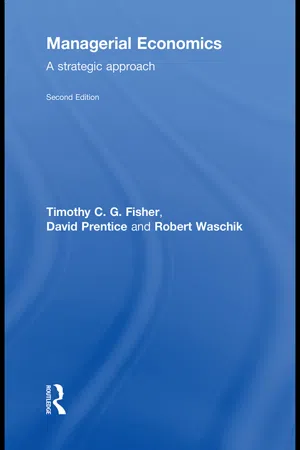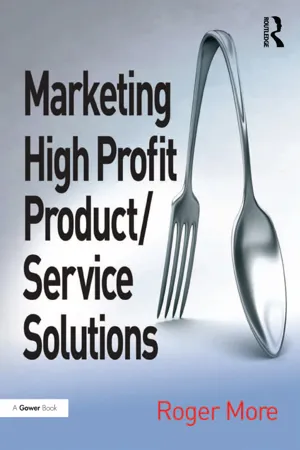Economics
Bundling
Bundling is a marketing strategy where two or more products or services are offered together as a package deal. This approach is often used to increase sales and profits by offering customers a discount for purchasing multiple items at once. Bundling can also be used to promote less popular products by pairing them with more popular ones.
Written by Perlego with AI-assistance
Related key terms
5 Key excerpts on "Bundling"
- eBook - ePub
Managerial Economics
A Strategic Approach
- Robert Waschik, Tim Fisher, David Prentice(Authors)
- 2010(Publication Date)
- Routledge(Publisher)
Second, some products may be included in a bundle because of their option value. Consider the computer software example: even if the consumer does not currently use the software, they value having the software readily accessible in case they might use it in the future. While these two reasons may well explain many cases of Bundling, we will just note that these reasons exist and assume that they do not apply to the models we will build in this chapter. The practice of Bundling and the similar practice of tie-ins will be analysed as ways that firms use to carry out second-degree price discrimination or to otherwise extract consumer surplus and increase profits beyond the level achievable by linearly pricing the products included in the bundle. In this chapter we first discuss the primary way firms can bundle products to increase profitability through a set of simple examples. We then introduce a more general framework that can be used to describe market outcomes with Bundling. Finally, we discuss tie-ins. 16.1 Bundling The simplest interpretation of Bundling is that it can be interpreted as a practice to take advantage of the diverse valuations of different products that consumers have. Suppose a firm offers two products for sale: good 1 and good 2. The nature of the relationship between these products is made clear by assuming that the valuation each consumer places on consuming each product is independent of the valuation from consuming the other. This means that the total valuation of the two products is equal to the sum of the valuations for each product. So the products may be completely different or related as long as the consumer will obtain value from consuming both products. Note how this differs from the case of second-degree price discrimination, where each consumer chose only one product from the menu offered. To demonstrate the returns to Bundling, consider a market with four consumers, labelled A, B, C and D, and a monopolist selling two goods, 1 and 2 - eBook - ePub
- Robert O'Donoghue KC, Jorge Padilla(Authors)
- 2020(Publication Date)
- Hart Publishing(Publisher)
Chapter 11 TYING AND Bundling11.1 . INTRODUCTIONDefinition. Tying and Bundling generally refer to the combined sale of more than one product. Various types of tying and Bundling can be distinguished, depending on how many components of a bundle/tie are also sold individually. At least three variants are distinguishable under EU competition law:1. Pure Bundling is observed when neither of the package components is offered individually; they can only be acquired as part of the bundle. Thus, given two products, A and B, only the package A-B is available. Moreover, they are typically, though not always, offered in fixed proportions: e.g., a bottle of shampoo with a bottle of hair conditioner. Examples of pure Bundling are fixed price lunch menus, bed with breakfast accommodation, and mandatory warranties. In Napier Brown-British Sugar ,1 for instance, the Commission condemned British Sugar’s practice of denying its customers the possibility to collect their orders directly from the factory, forcing them instead to use the producer’s delivery service.2. Tying refers to situations where some of the goods contained in a package are offered on their own (the so-called tied products), whereas others are not available individually (the tying products). Thus, consumers of the latter (the tying products) are forced to acquire the former (the tied products). For example, given two products, A and B, if product A is tied to product B a customer who wants to buy A must also buy B, whereas it is possible to buy product B without buying product A. Moreover, products can be tied together physically (i.e., a technological integration) as well as through contractual obligations that prescribe joint sale (i.e., a contractual tie). In Microsoft , the Commission found that Microsoft abused its dominant position by requiring OEMs to ship their PCs with Windows Media Player pre-installed. The Commission also concluded that such arrangement amounted to a technological tie from the perspective of consumers since it was impossible to remove the media player once installed by the OEM.2 - Luigi Paganetto(Author)
- 2017(Publication Date)
- Routledge(Publisher)
Bundling also helps minimize selling and billing costs. Bundling allows the seller to maintain a single inventory entry for the bundle, rather than individual inventory records for each component in the package. Likewise, the seller can submit a single bill for the entire bundle, rather than a separate charge for each component.Bundling also promotes incentives for sellers to assemble supplies and other complementary goods that work well together. When a durable capital good and other complementary goods are sold separately, purchasers may buy complementary goods of inefficiently low quality, causing the capital good to operate poorly. When the inferior complements make the whole system malfunction, the manufacturer of the core good or service may suffer unwarranted damage to its reputation that may well extend to many potential customers.This issue is most likely to arise when the technology is complex, and quality differences among competing brands of the complementary goods are hard to detect. First, buyers may simply be poorly informed about the specifications of the complementary goods needed for optimum performance, Moreover, when components are sold on a stand-alone basis, sellers may have inadequate incentives to inform consumers about system requirements. This is a ‘free rider’ problem: many of the benefits of educating buyers go to sellers of complementary or competing goods, even when these sellers contribute nothing to the cost of the education campaign. Second, because some costs of damage to a manufacturer’s reputation are external to any individual buyer, even, educated buyers may buy complements of poorer quality than optimal. Bundling can reduce the informational and other free rider problems. When the same vendor sells the bundle of complementary products – ‘the system’ – the vendor can set the quality of the complementary goods at the level necessary to make the system work, and can capture (through increased sales or profits) all the benefits of educating purchasers about the requirements for proper system operation.2- eBook - ePub
Competition, Regulation, and Convergence
Current Trends in Telecommunications Policy Research
- Sharon E. Gillett, Ingo Vogelsang(Authors)
- 1999(Publication Date)
- Routledge(Publisher)
Moreover, it is a straightforward implication of our model that bundled pricing can serve as a deterrent to innovation. Consider the situation of Firm 2 before it invests in designing product B*. Firm 2 can anticipate that once B* hits the market, Firm 1 will bundle its products so as to render B* unprofitable. This discourages Firm 2 from making the investment at all. Even if Firm 2 would enjoy some period of delay before Firm 1 could execute the Bundling strategy, it would not be profitable to invest in the innovation as long as the delay is not too great relative to the investment cost. Hence, the conventional wisdom that Bundling by Microsoft has dampened innovation is consistent with the results of our model. When bundled pricing is precluded, there is always an equilibrium in which customers can buy their preferred product B* on an unbundled basis. This maximizes total social welfare. However, in the new buyer scenario, even precluding bundled pricing is not sufficient to alleviate exclusion, because apparently unbundled prices can perfectly mimic the bundled prices. In the latter case, structural remedies may be necessary. ACKNOWLEDGMENTS An early version of this analysis was developed as part of the authors’ work on behalf of Universal Studios, Inc., an interested party to the deliberations by the Commission of the European Communities regarding the German digital pay TV joint venture proposed by Bertelsmann and Kirch in 1997. REFERENCES Adams, W., & Yellen, J. L. (1976). Commodity Bundling and the burden of monopoly. Quarterly Journal of Economics, 90, 475–498. Bakos, Y., & Brynjolfsson, E. (1998, October). Bundling and competition on the Internet: Aggregation strategies for information goods. Paper presented at the 26 th annual Telecommunications Policy Research Conference, Alexandria, VA. McAfee, R. P., McMillan, J., & Whinston, M. D. (1989) - eBook - ePub
- Roger More(Author)
- 2016(Publication Date)
- Routledge(Publisher)
1 The Global Expansion of New Product/service Integrated Customer Solutions: The Bundling ConceptRoger More, 2012In rapidly changing global competitive business to business (B2B) marketplaces, one of the fastest growing competitive market strategies is the Bundling of complex value-added integrated product/service customer solutions.Introduction
The huge growth in the size and complexity of integrated product/service bundled market offerings in virtually every competitive global business-to-business market represents important future competitive opportunities for many companies. Companies are increasingly competing on “bundles” of products and services that differentiate them and that customers will value and choose. This chapter will map and outline what products are, what services represent, and the different strategic choices companies have for product/service strategies in different competitive markets, citing many examples. It will outline and illustrate product-centric strategies, service-centric strategies and product/service integrated strategies. The changes in product/service integration and Bundling represent great opportunities to grow markets and long-term potential cash flows for many companies of all sizes and industries. It is important for managers to be clear about the differences and connections between products and services in B2B markets.The chapter will then proceed to map the most important alternative product/service market positions that need to be considered. It will outline three different broad market focus positions – product-centric bundles, service-centric bundles, and product/service integrated bundles – examining a series of companies that exemplify these strategic choices in their product and service portfolios. The chapter will conclude with a series of important questions for managers facing these difficult product and service strategic choices.
Learn about this page
Index pages curate the most relevant extracts from our library of academic textbooks. They’ve been created using an in-house natural language model (NLM), each adding context and meaning to key research topics.




